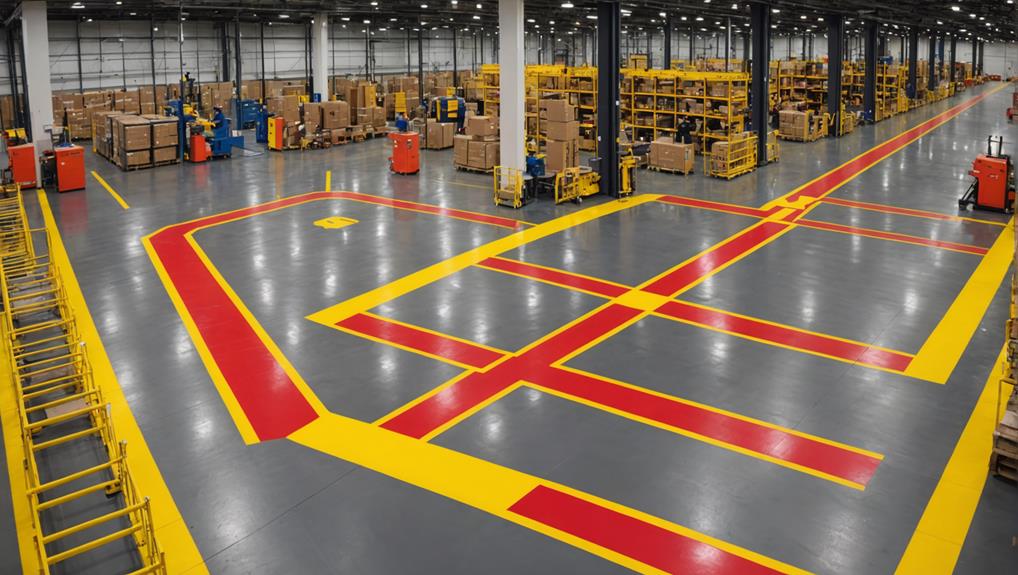To guarantee safety in your warehouse, use effective floor marking techniques. Start by implementing clear color coding—red for danger, yellow for caution, and green for safety zones. Choose the right materials, like tape for temporary markings or durable paint for permanent solutions. Ascertain pathways are unobstructed and markings are visible from a distance. Regularly check and maintain your markings to keep them in good condition. Train your employees on the meanings and importance of these markings. By following these guidelines, you'll enhance safety and efficiency on the pavimento, and there's more valuable insight waiting for you just ahead.
Importance of Floor Marking
When it comes to workplace safety, effective floor marking is essential. It serves as a clear visual guide, helping employees navigate their environment safely and efficiently. By utilizing floor markings, you create defined pathways, designate hazardous areas, and outline work zones, all of which contribute to maintaining a structured and organized facility.
The visual impact of floor markings cannot be underestimated. Bright colors and clear symbols grab attention, making it easier for staff to recognize important information at a glance. This immediacy reduces the likelihood of accidents, as employees can quickly identify safe walking paths or areas requiring caution. In a busy warehouse, where distractions are common, a well-marked floor can be the difference between safety and injury.
Moreover, effective floor marking plays a vital role in fostering a strong safety culture within your organization. It reinforces safe behaviors and encourages everyone to take responsibility for their safety and the safety of their coworkers. When employees see clear, consistent markings, it sends a message that safety is a priority. This collective understanding can lead to improved compliance with safety protocols, ultimately reducing incidents and promoting a healthier work environment.
Types of Floor Marking Materials
Choosing the right floor marking materials is essential for ensuring durability and visibility in your workspace. You've got several options, each with its advantages and disadvantages. Understanding these can help you make an informed decision that enhances safety.
Here's a quick overview of common floor marking materials:
- Nastro: Easy to apply and remove, tape is great for temporary markings. It's available in various colors and widths, making it versatile.
- Paint: Offers a more permanent solution, paint can withstand heavy traffic. However, it requires more time for application and drying.
- Reflective materials: These materials enhance visibility in low-light conditions, making them ideal for high-traffic areas or where safety is a priority.
- Floor decals: Perfect for specific messages or branding, these can be customized and applied to any flooring type.
When considering tape versus paint, think about the longevity and maintenance of each option. Tape may need replacement every few months, while paint can last several years if properly maintained. Reflective materials can further elevate safety by ensuring visibility even in dimly lit areas.
Ultimately, the right choice depends on your specific needs and environment. By selecting appropriate materials, you'll create a safer workspace that effectively communicates important safety guidelines. Always prioritize both visibility and durability to maintain a compliant and secure warehouse.
Color Coding Systems
Implementing a color coding system can greatly enhance safety and efficiency in your workspace. By using a well-thought-out color scheme, you can leverage color psychology to influence behavior and improve awareness among your team. Colors can evoke emotions and reactions, making them powerful tools for conveying important information quickly.
When selecting colors, consider marking contrast—ensure that your chosen colors stand out against the warehouse floor. This will help minimize accidents by clearly defining safe zones, walkways, and hazardous areas.
Here's a simple guide to help you choose effective colors for your marking system:
| Color | Meaning | Usage Example |
|---|---|---|
| Red | Danger/Stop | Fire exits, emergency areas |
| Yellow | Caution/Warning | Caution zones, slippery areas |
| Green | Safety/Go | First aid stations, safe zones |
| Blue | Information | Instruction areas, storage locations |
| Orange | Warning/Alert | Equipment maintenance, caution signs |
Designing Effective Layouts
Designing effective layouts is essential for maximizing safety and efficiency in any workspace. Proper layout optimization not only enhances workflow but also minimizes the risk of accidents. By implementing strategic spatial organization, you can create a safer environment for your team. Here are some key considerations for designing effective layouts:
- Clear pathways: Confirm that aisles and walkways are unobstructed, allowing for easy movement and reducing the chance of collisions.
- Logical zoning: Group similar functions or items together to streamline operations and make navigation intuitive.
- Emergency access: Design your layout with safety in mind; confirm that emergency exits and equipment are easily accessible.
- Visual cues: Use floor markings to guide personnel and indicate safe zones, storage areas, and operational zones.
When focusing on layout optimization, consider the specific needs of your warehouse. Remember that a well-organized space can notably reduce the likelihood of accidents while enhancing productivity. Take the time to measure your available space and analyze workflow patterns. This proactive approach allows you to make informed decisions about equipment placement and employee movement.
Regularly review and adjust your layout as necessary, particularly when new equipment or processes are introduced. Continuous improvement is key to maintaining a safe and efficient workspace. By prioritizing effective layout design, you're investing in the safety and well-being of your team, ultimately leading to a more productive and harmonious work environment.
Hazardous Area Indicators
In any workspace, clearly marking hazardous areas is vital for guaranteeing safety and preventing accidents. Proper hazard identification is the first step in creating a safe environment. By using bold floor markings, you can effectively communicate the presence of dangers such as chemical storage, electrical hazards, or heavy machinery zones.
When you implement hazardous area indicators, make sure they're easily recognizable. Use vibrant colors like yellow or red, which are universally associated with caution and danger. These colors help to communicate risks quickly, making it easier for employees to stay alert and informed.
Visual communication is fundamental in warehouses, where distractions are common. It's not just about the color, though; consider the patterns you use. Stripes, circles, or even specific symbols can enhance understanding and reinforce the warning. For instance, diagonal stripes might indicate a particularly dangerous area, while a solid line could denote less immediate hazards.
Place these indicators at eye level where possible, and make sure they're maintained regularly. Faded or unclear markings can lead to confusion and potential accidents. Regular training sessions can also help reinforce the importance of these indicators, reminding employees to be vigilant and aware.
Incorporating effective hazardous area indicators into your safety strategy not only promotes a culture of safety but also greatly reduces the likelihood of accidents. By prioritizing hazard identification and clear visual communication, you're taking a proactive approach to workplace safety that benefits everyone.
Directional Arrows and Symbols
Effective communication of hazards is just one part of a thorough safety strategy; equally important is guiding movement within the workspace. Directional arrows and symbols are essential tools that help guarantee efficiency and safety in your warehouse. Proper arrow placement and symbol clarity can greatly reduce the risk of accidents while facilitating smooth workflows.
When using directional arrows and symbols, consider these key aspects:
- Visibility: Make sure arrows and symbols stand out against the floor color to be easily seen.
- Coerenza: Use a standardized design for all markings to avoid confusion.
- Placement: Position arrows strategically at decision points, such as intersections and doorways, to guide movement.
- Size: Ensure that the arrows and symbols are large enough to be visible from a distance.
Maintenance of Floor Markings
Proper maintenance of floor markings is vital for guaranteeing a safe and efficient workspace. Regular inspections are important to identify any wear and damage that may compromise visibility and safety. By routinely checking the condition of your floor markings, you can address issues before they escalate, helping to maintain a clear and organized environment.
Here's a simple breakdown of recommended maintenance practices:
| Attività di manutenzione | Frequenza | Repair Techniques |
|---|---|---|
| Visual Inspections | Settimanale | Touch-up paint, reapply tape |
| Pulizia profonda | Mensile | Use appropriate cleaning agents |
| Full Replacement | Annualmente | Sand, clean, and repaint |
When conducting your inspections, pay attention to areas that experience high traffic, as these markings are more prone to damage. Should you notice fading or peeling, consider using repair techniques like touch-up painting or reapplying tape to restore the markings' visibility.
Additionally, don't forget that a clean surface improves adhesion for any repairs. Regularly cleaning the area guarantees that dirt and grime don't interfere with the effectiveness of your floor markings. By following these practices, you'll not only enhance the safety of your warehouse but also extend the life of your floor markings. Remember, proactive maintenance is key to preventing accidents and creating a workplace that prioritizes safety.
Training Employees on Markings
Understanding floor markings is essential for every employee in the workplace. Proper training not only enhances marking awareness but also reinforces safety protocols, ensuring a secure environment for everyone. When employees know what each marking means, it leads to better compliance and fewer accidents. Here are some key aspects to focus on during employee training:
- Types of Markings: Familiarize yourself with different floor markings, such as safety zones, walkways, and storage areas.
- Color Codes: Learn the significance of various colors used in floor markings, as each color conveys specific safety information.
- Best Practices: Understand the best practices for traversing spaces with markings, including proper distancing and recognizing hazards.
- Engagement Techniques: Participate in interactive sessions that promote employee engagement and encourage questions about the markings.
It's vital to create a culture of safety where every team member feels responsible for adhering to these guidelines. Regular training sessions should be held to refresh marking awareness and keep safety at the forefront of your workplace culture. Incorporating real-life scenarios during training can help employees relate better and remember the importance of floor markings.
Compliance With Safety Standards
Compliance with safety standards is essential for maintaining a secure workplace environment. By adhering to regulatory requirements, you not only protect your employees but also minimize the risk of costly accidents and legal issues. Implementing proper floor marking techniques is a significant part of this compliance.
To guarantee your marking practices meet safety standards, consider the following key elements:
| Element | Importanza |
|---|---|
| Regulatory Requirements | Guarantee all markings meet OSHA and ANSI guidelines. |
| Safety Audits | Regularly review your floor markings to identify areas for improvement. |
Safety audits can help you evaluate your current marking strategies and identify gaps in compliance. They provide an opportunity to review whether your floor markings are visible, clear, and correctly placed. Regular audits also guarantee that any changes in regulatory requirements are promptly addressed, keeping your workplace aligned with the latest safety standards.
Moreover, maintaining compliance isn't a one-time task. It requires ongoing attention and updates to your safety protocols. Make it a point to train your staff on the significance of these markings and how they contribute to overall safety.
Evaluating Marking Effectiveness
Effectively evaluating your floor markings is essential for guaranteeing they serve their intended purpose in promoting safety. Regular assessment helps you maintain marking longevity and visual clarity, which are critical for effective navigation and hazard identification in your warehouse. Here are a few key factors to take into account during your evaluation:
- Visibility: Check if the markings are easily seen from a distance. Faded or worn markings can lead to confusion and accidents.
- Durata: Assess the condition of your floor markings. Are they showing signs of wear and tear? Regular inspections can help you identify when it's time for a refresh.
- Compliance: Verify your markings meet industry standards and regulations. Non-compliance can lead to safety violations and increased liability.
- Feedback: Gather input from employees about the effectiveness of the markings. They can provide valuable insights into how well the markings guide them in their daily tasks.
Domande frequenti
What Tools Are Needed for Applying Floor Markings?
Did you know that 20% of workplace injuries are due to slips, trips, and falls? To effectively apply floor markings, you'll need the right tools. Start with high-quality marking materials like tape or paint, guaranteeing they're durable and visible. Consider application methods like stencils or rollers for precision. Don't forget safety gear like gloves and masks to protect yourself during the process. Proper preparation guarantees a safer environment for everyone.
How Often Should Floor Markings Be Refreshed or Replaced?
You should refresh or replace floor markings based on their marking durability and visual clarity. Typically, every 6 to 12 months is a good guideline, but this can vary depending on traffic levels and environmental factors. Regular inspections will help you determine when markings start to fade or wear down. Keeping them visible is essential for safety, ensuring everyone can easily identify pathways and hazards in your workspace.
Can I Use Tape Instead of Paint for Markings?
Can you really rely on tape instead of paint for your markings? Absolutely! While tape can offer immediate marking visibility, its durability can vary based on the environment. For high-traffic areas, consider using industrial-grade tape designed for longevity. Unlike paint, tape's easy to apply and replace, making maintenance simpler. Just guarantee you're choosing the right type for your specific needs to maintain safety and effectiveness in your workspace.
What Is the Cost of Implementing Floor Marking Systems?
Implementing floor marking systems involves several budget considerations, including initial costs for materials and labor. While upfront expenses can vary, think about the long-term savings from improved safety and efficiency. Investing in durable markings can reduce accidents and maintenance needs, ultimately saving you money over time. It's essential to assess your specific requirements and choose a solution that balances cost with the benefits of a safer environment for everyone involved.
How Can I Assess Employee Compliance With Floor Markings?
Picture a well-orchestrated dance, where each movement aligns with the rhythm of safety. To assess employee compliance with floor markings, implement regular compliance monitoring and reinforce employee training. Conduct audits to observe whether employees are following designated paths. Use feedback sessions to address issues and encourage adherence. By fostering a culture of safety awareness, you'll guarantee that everyone understands the importance of these markings, creating a safer environment for all.




